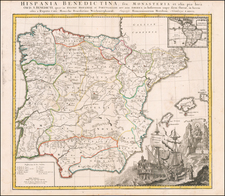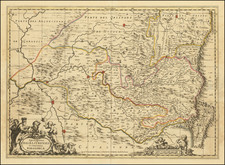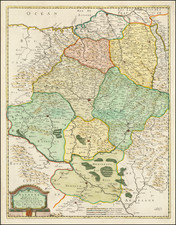Detailed map showing southern Spain (Baetica Hispanica) at the time of Caesar and the Roman Empire.
Hispania Baetica was one of three Imperial Roman provinces in Hispania, (modern Iberia). Hispania Baetica was bordered to the west by Lusitania, and to the northeast by Hispania Tarraconensis. Baetica was part of Al-Andalus under the Moors in the 8th century and approximately corresponds to modern Andalucia. Its capital was Corduba.
The Roman conquest of Hispania was a historical period that began with the Roman landing at Empúries in 218 BC and ended with the Roman conquest of the Iberian Peninsula, then Hispania, by Caesar Augustus after the Cantabrian wars in 19 BC.
Long before the First Punic War, between the 8th and 7th centuries BC, the Phoenicians (and later the Carthaginians) had already appeared in the southern part of the Iberian Peninsula as well as in the East, to the south of the Ebro. Their numerous commercial settlements based throughout these coastal strips provided an outlet into Mediterranean commerce for minerals and other resources of pre-Roman Iberia. These installations consisting of little more than warehouses and wharves allowed not only exports, but also the introduction to the Peninsula of products manufactured in the Eastern Mediterranean. This had the indirect effect of the native peninsular cultures adopting certain Eastern characteristics.
During the 7th century BC, the Greeks established their first colonies on the northern Mediterranean coast of the peninsula. Setting off from Massalia (Marseille) they founded the cities of Emporion (Ampurias) and Rhode (Roses), although at the time they had already spread throughout the coastal commercial centers of the region without establishing a permanent presence. Part of this Greek commerce was nevertheless carried out by Phoenician shipping; Phoenician trade in the peninsula included articles both coming from and heading to Greece. As a commercial power of the Western Mediterranean, Carthage expanded its interests to the island of Sicily and the south of Italy. This growing influence over the region soon proved to be an annoyance for Rome. This conflict of commercial interests ultimately led to the Punic Wars of which the First Punic War ended in an unstable armistice. The mutual hostility led to the Second Punic War, which, after twelve years of conflict, resulted in effective Roman domination of the south and east of the Iberian Peninsula. Later, a decisive defeat for Carthage at Zama would wipe that city from the historical scene.
Despite having vanquished their rival Mediterranean power, the Romans still took another two centuries to bring the entire Iberian Peninsula under their control through an expansionist policy that earned the enmity of practically all of the tribes of the interior. The abuses to which these people were submitted is considered to be responsible for the strong anti-Roman sentiment throughout these nations. After years of bloody conflict, the indigenous people of Hispania were finally crushed by the military and cultural heel of Rome, thus disappearing from the face of history. However, in the Roman Empire people kept their ancestral identifications but also were loyal to the Roman state, so even though the language became Latin, the 'gens' continued being local.
Pierre Duval (1618-1683) was a French geographer, cartographer, and publisher who worked in Abbeville and Paris during the seventeenth century. He was born in the former city, in northeast France, before moving to Paris. Duval was the nephew of the famous cartographer Nicolas Sanson, from whom he learned the mapmaker's art and skills. Both men worked at the royal court, having followed the royal request for artists to relocate to Paris. In addition to numerous maps and atlases, Du Val's opus also includes geography texts. He held the title of geographe ordinaire du roi from 1650 and died in 1683, when his wife and daughters took over his business.









![Conil [with] Xeres De La Frontera](https://storage.googleapis.com/raremaps/img/small/76392.jpg)
![[Penisola Castle / Valencian/Catalan Coast] Coste d'Espagne depuis Peniscola Jusqu'au Hamau du Canard ou Alcanario (hand drawn map)](https://storage.googleapis.com/raremaps/img/small/91695.jpg)



![[Andalusia] Andaluzia continens Sevillam et Cordubam](https://storage.googleapis.com/raremaps/img/small/84573.jpg)